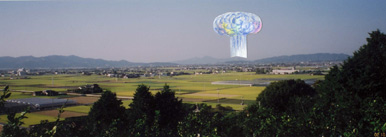Art of the Hibakusha
Like so many others, we have been following the marking of the 60th anniversary of the atomic bombing of Hiroshima, then Nagasaki tomorrow. This made us recall the stories once told us by two Japanese-Canadian friends now in their seventies who were living in Japan during the war. Setsuko vividly remembers the day Tokyo was bombed (not atomic). About ten years old at the time, she picked up her youngest brother, an infant, and ran and ran and ran. All her family survived but many of their neighbours and friends did not. She relived that day in nightmares for many years.

Our friend Tomio has just kindly emailed me his story again, and I quote it in its vivid entirety:
I did my best to place a mushroom cloud over Nagasaki in my panorama picture (above) which I took when we visited our homes about four years ago. Nagasaki is 80 km away from my old home in a countryside. The picture was taken in the autumn of that year, and the bomb was dropped over Nagasaki when some low cumulous clouds were beginning to appear over the distant mountains or hills you can see. The rice fields were not yellow but dark green with yet-to-ripe rice plants. The skies were as blue as you can see on the picture and a few clouds beyond the hills were brightly shining.
I was 13 years old and on summer holidays from school. The countryside of Kyushu Island was calm in spite of the fact that American invasion was supposed to be imminent at a southern tip of Kyushu Island. I guess Japanese homeland forces were devastated and defenseless not requiring American forces to bomb any more. Tokyo was almost completely devastated to the ground anyway. We, Kyushu Island citizens, were expected to fight to the last man along with the military forces. Almost all the young men were fighting abroad, and old folks, their wives, and children were working in the rice fields.
On that day, I visited my friend whose parents owned a pear orchard on a hillside. After enjoying delicious pears as a guest, I started to walk downhill towards my home. I think it was about two o’clock in the afternoon. When I reached a point of clear view of the plain below, I suddenly noticed an ominous clouds towering into the sky over the distant hills. I stopped walking and watched it, and the first thing I imagined was some ominous change in the universe although I had heard on radio about a new type of bomb dropped over Hiroshima prior to that day.
The side of the mushroom shape was faintly tinted with colours (spectrum of light) and looked pretty. The mushroom shape seemed standing still (although it started to disintegrate very slowly and mix with with the surrounding shining cumulous clouds towards the late afternoon), and the atmosphere was quiet without any sound of enemy or friendly airplanes used to fly over up to about 10 days ago. Then, I resumed descending the hill with a puzzled mind toward my home.
Of all that’s been written on this subject, Mark Vallen’s post about the art of the survivors struck my artist’s soul the most.
August 6th, 2005, marks the 60th anniversary of the atomic bombing of Japan. August 9th, marks the bombing of Nagasaki. Those who survived the blasts became known as hibakusha (Atom Bomb Survivors), and in 1974 the hibakusha began contributing artworks to an unusual project that would preserve for the world their memories of atomic fire.
Do read the rest, about Vallen’s involvement and the website Art of the Hibakusha, that he has upgraded to commemorate the first… and hopefully last atomic war. The paintings comprising this exhibition are sober reminders of the reality of atomic warfare, created by people who actually lived through an atomic holocaust.
Also don’t miss reading about the amazing and powerful Hiroshima Panels, comparable to Picasso’s Guernica. View them at this online gallery.

Melting Hand by Takakura Nobuko
August 8, 2005 in History, Other artists by Marja-Leena
I have just spent a long time looking at the panels, and though I have seen quite a few harrowing memorial programmes this week, here is the most powerful and haunting representation of what took place. It is good to be reminded.
I was teaching a research session for an American History high school teacher who was justifying the bombings to her young students. It made me want to cry. There was a very graphic Japanese animated video I watched when I was 18 or 19 called “Barefoot Gen” and I became so horrified, putting the tragedy into human terms. The description of the pretty colors in the clouds and the image above are so moving. It is important that we not protect ourselves from such images, that we work towards preventing such a thing from ever happening again.
Art is most powerful when it moves us in this way, when our personal experiences and observations are tweaked as well. It does strengthen our desire to avoid another horrible tragedy but how do we make our world leaders stop making nuclear weapons?